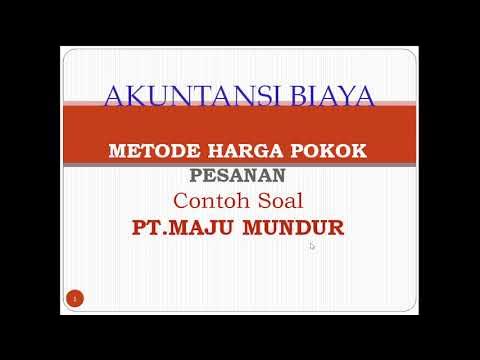METODE HARGA POKOK PESANAN 2 : JURNAL DAN KARTU PESANAN
Summary
TLDRThis video provides an in-depth explanation of the cost accounting method known as job order costing. It covers key concepts like the recording of direct materials, labor, and factory overhead in the production process. Detailed journal entries are explained for purchasing materials, paying wages, and allocating overhead. The video also emphasizes the importance of tracking costs for each order through job sheets and provides examples for calculating total production costs and per-unit costs. The goal is to help viewers understand how to properly record and report these costs in financial statements.
Takeaways
- 😀 The video discusses the concept of Job Order Costing, specifically focusing on the journals and costing sheets involved in tracking production costs for specific orders.
- 😀 The script outlines the different steps of the costing cycle, including the purchase of raw materials, labor costs, and factory overhead.
- 😀 Key production costs are categorized into direct materials, direct labor, and overhead, which are all tracked separately during the production process.
- 😀 Direct material costs are recorded when raw materials are used in production, and the journal entry for this is debiting the work in process and crediting the raw materials inventory.
- 😀 Labor costs, especially direct labor, are tracked and journalized when workers' wages are assigned to production orders, with adjustments for direct and indirect labor.
- 😀 Factory overhead is calculated and applied to production based on predetermined rates, and is journalized separately from direct costs.
- 😀 The video emphasizes that when raw materials or labor are used, a journal entry must be made for each, tracking the movement of resources from inventory to work in progress.
- 😀 Once goods are produced, they are moved from work in process to finished goods, and another journal entry is made to reflect the change in inventory status.
- 😀 At the end of the period, unfinished goods are recorded as inventory in process, and the related journal entries help track the uncompleted orders.
- 😀 The final cost of goods sold is determined by calculating the difference between the total costs incurred for production and the sales revenue, which is crucial for profit margin calculations.
Q & A
What is the main topic of the video?
-The video focuses on explaining the job order costing method in accounting, specifically discussing journal entries, cost tracking, and reporting in the production process.
What are the three main types of production costs discussed in the video?
-The three main types of production costs discussed are direct materials (bahan baku), direct labor (tenaga kerja langsung), and manufacturing overhead (overhead pabrik).
How is the journal entry recorded when raw materials are purchased?
-When raw materials are purchased, the journal entry is: Debit 'Raw Materials Inventory' (asset increases), and Credit 'Accounts Payable' (if not paid immediately).
What happens to raw materials once they are used in production?
-Once raw materials are used in production, they are moved from 'Raw Materials Inventory' to 'Work in Process' as part of the cost of production.
How are wages and salaries related to production accounted for?
-Wages and salaries for direct labor are debited to 'Work in Process', while wages for indirect labor, such as supervisors, are debited to 'Manufacturing Overhead'.
What is the significance of overhead costs in the job order costing system?
-Overhead costs are indirect costs, such as factory depreciation or utilities, which cannot be directly traced to a specific product. These are applied to the job based on a predetermined overhead rate.
How is the manufacturing overhead applied to jobs in the accounting system?
-Manufacturing overhead is applied to jobs using a predetermined overhead rate, which is based on an estimated cost, often a percentage of direct labor or direct material costs.
What is the difference between 'Work in Process' and 'Finished Goods' inventory?
-'Work in Process' refers to products that are in the production process but not yet completed, while 'Finished Goods' refers to products that are completed and ready for sale or delivery.
How are unsold or unfinished goods at the end of the period recorded?
-At the end of the period, unsold or unfinished goods are recorded as 'Work in Process' inventory. The costs associated with these goods are also included in the financial reports.
What is the journal entry for the sale of finished goods?
-When finished goods are sold, the journal entry is: Debit 'Accounts Receivable' or 'Cash' (for the sale amount), Credit 'Sales Revenue'. Additionally, 'Cost of Goods Sold' is debited, and 'Finished Goods Inventory' is credited for the cost of the goods sold.
Outlines

This section is available to paid users only. Please upgrade to access this part.
Upgrade NowMindmap

This section is available to paid users only. Please upgrade to access this part.
Upgrade NowKeywords

This section is available to paid users only. Please upgrade to access this part.
Upgrade NowHighlights

This section is available to paid users only. Please upgrade to access this part.
Upgrade NowTranscripts

This section is available to paid users only. Please upgrade to access this part.
Upgrade Now5.0 / 5 (0 votes)





